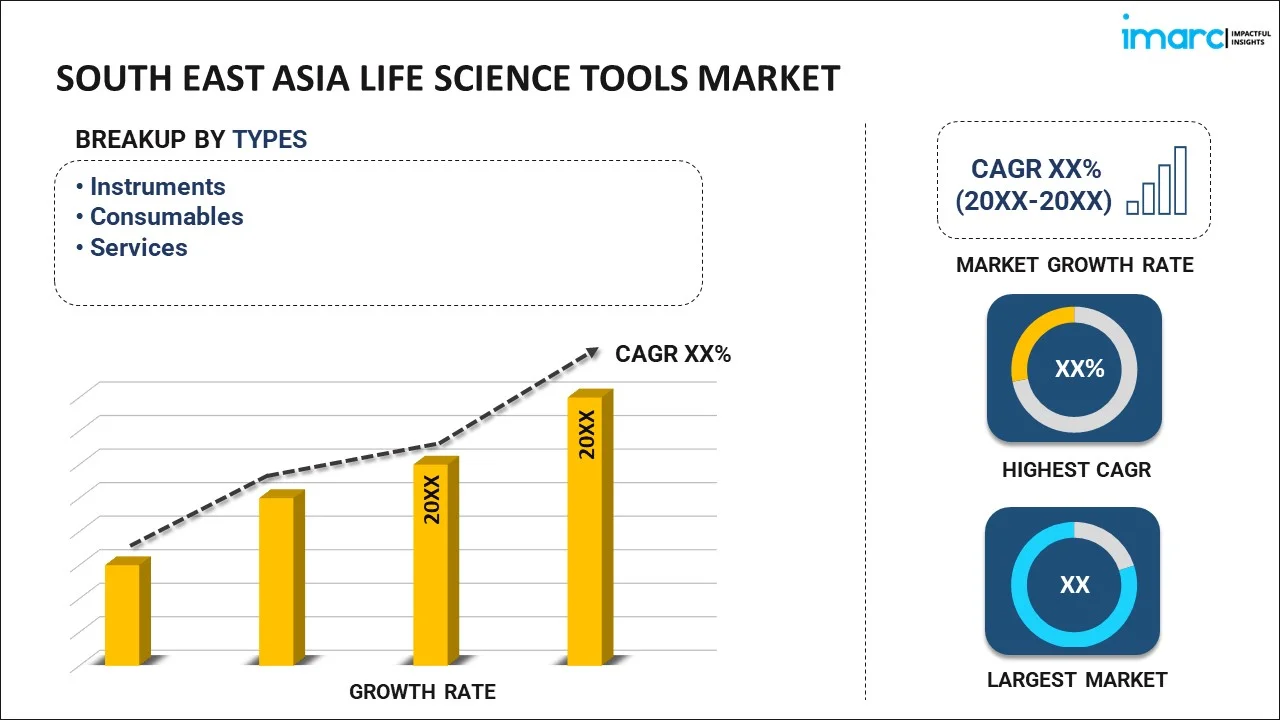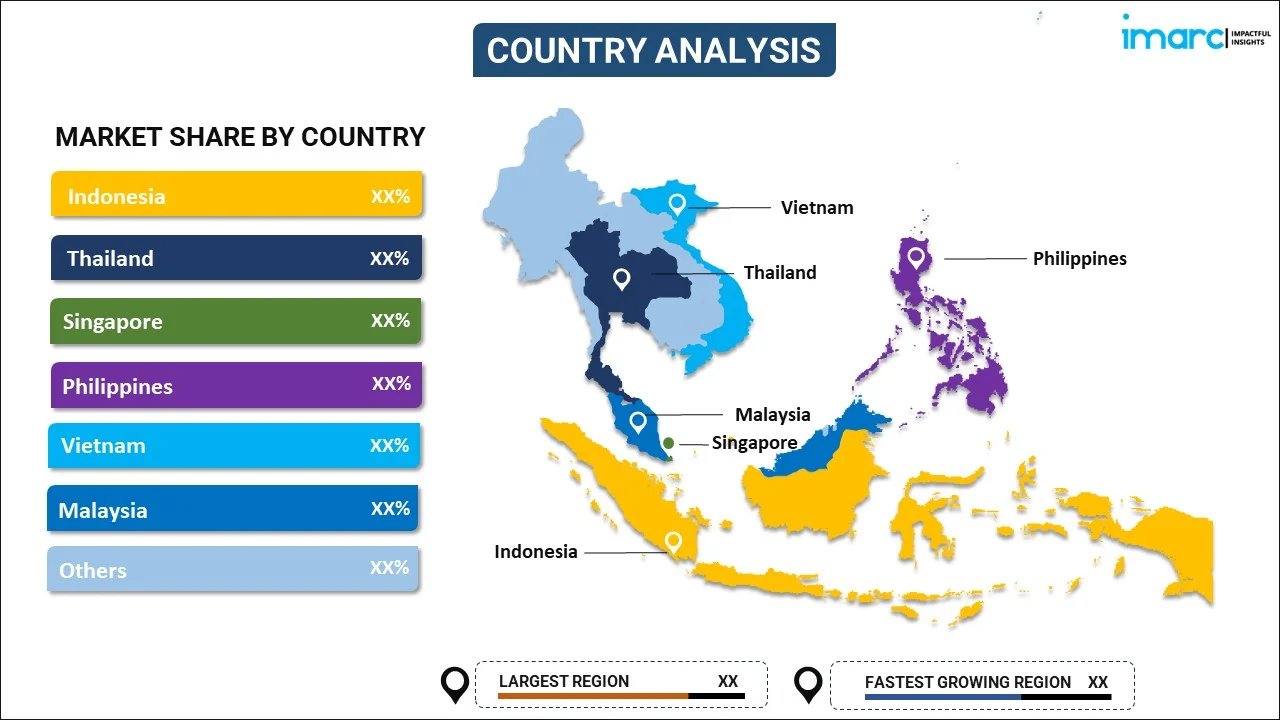
South East Asia Life Science Tools Market Report by Type (Instruments, Consumables, Services), Technology (Cell Culture Systems and 3D Cell Culture, PCR and qPCR, Sanger Sequencing, Separation Technologies, Flow Cytometry, Nucleic Acid Microarray, Mass Spectrometry, and Others), Application (Proteomics Technology, Genomic Technology, Cell Biology Technology, and Others), End User (Government and Academic, Biopharmaceutical Company, Healthcare, Industrial Applications, and Others), and Country 2025-2033
Market Overview:
South East Asia life science tools market size reached USD 6.2 Billion in 2024. Looking forward, IMARC Group expects the market to reach USD 11.5 Billion by 2033, exhibiting a growth rate (CAGR) of 7.2% during 2025-2033. The increasing prevalence of chronic diseases, along with a growing aging population, which propels drug discovery and development efforts, leading to a higher demand for tools in these industries, is driving the market.
|
Report Attribute
|
Key Statistics
|
|---|---|
|
Base Year
|
2024 |
|
Forecast Years
|
2025-2033
|
|
Historical Years
|
2019-2024
|
| Market Size in 2024 | USD 6.2 Billion |
| Market Forecast in 2033 | USD 11.5 Billion |
| Market Growth Rate (2025-2033) | 7.2% |
Life science tools encompass a diverse array of instruments, technologies, and equipment specifically designed for research and experimentation in the biological sciences. These tools play a pivotal role in advancing the understanding of living organisms at the molecular, cellular, and organismal levels. Key components include microscopes, DNA sequencers, centrifuges, chromatography systems, and various analytical instruments. Microscopy enables the visualization of intricate cellular structures, while DNA sequencers facilitate genetic analysis and sequencing. Centrifuges separate biological materials based on density, and chromatography systems aid in purifying and analyzing complex mixtures. These tools empower scientists in fields such as genomics, proteomics, and cell biology, contributing to breakthroughs in medical research, drug development, and biotechnology. As technology advances, life science tools continue to evolve, enabling researchers to delve deeper into the complexities of life, unraveling mysteries, and driving innovation in the quest for improved healthcare and a deeper understanding of biological systems.
South East Asia Life Science Tools Market Trends:
The life science tools market in South East Asia is experiencing robust growth due to several key drivers. Firstly, advancements in technology have propelled the development of cutting-edge tools, fostering a surge in demand. Additionally, the increasing focus on personalized medicine has led to a growing need for sophisticated life science tools that can facilitate precise diagnostics and treatment strategies. Furthermore, the expanding field of genomics and proteomics has necessitated more sophisticated tools for data analysis, driving the market forward. Moreover, collaborative initiatives between academia and industry players are fostering innovation, propelling the life science tools market to new heights. Furthermore, the escalating prevalence of chronic diseases is steering research efforts toward understanding complex biological mechanisms, further fueling the demand for advanced tools in life sciences. Overall, these interconnected factors underscore the dynamic landscape of the life science tools market in South East Asia, where technological advancements, healthcare trends, and collaborative endeavors converge to propel growth and innovation.
South East Asia Life Science Tools Market Segmentation:
IMARC Group provides an analysis of the key trends in each segment of the market, along with forecasts at the regional and country levels for 2025-2033. Our report has categorized the market based on type, technology, application, and end user.
Type Insights:

- Instruments
- Consumables
- Services
The report has provided a detailed breakup and analysis of the market based on the type. This includes instruments, consumables, and services.
Technology Insights:
- Cell Culture Systems and 3D Cell Culture
- PCR and qPCR
- Sanger Sequencing
- Separation Technologies
- Flow Cytometry
- Nucleic Acid Microarray
- Mass Spectrometry
- Others
A detailed breakup and analysis of the market based on the technology have also been provided in the report. This includes cell culture systems and 3D cell culture, PCR and qPCR, sanger sequencing, separation technologies, flow cytometry, nucleic acid microarray, mass spectrometry, and others.
Application Insights:
- Proteomics Technology
- Genomic Technology
- Cell Biology Technology
- Others
The report has provided a detailed breakup and analysis of the market based on the application. This includes proteomics technology, genomic technology, cell biology technology, and others.
End User Insights:
- Government and Academic
- Biopharmaceutical Company
- Healthcare
- Industrial Applications
- Others
A detailed breakup and analysis of the market based on the end user have also been provided in the report. This includes government and academic, biopharmaceutical company, healthcare, industrial applications, and others.
Country Insights:

- Indonesia
- Thailand
- Singapore
- Philippines
- Vietnam
- Malaysia
- Others
The report has also provided a comprehensive analysis of all the major regional markets, which include Indonesia, Thailand, Singapore, Philippines, Vietnam, Malaysia, and Others.
Competitive Landscape:
The market research report has also provided a comprehensive analysis of the competitive landscape. Competitive analysis such as market structure, key player positioning, top winning strategies, competitive dashboard, and company evaluation quadrant has been covered in the report. Also, detailed profiles of all major companies have been provided.
South East Asia Life Science Tools Market Report Coverage:
| Report Features | Details |
|---|---|
| Base Year of the Analysis | 2024 |
| Historical Period | 2019-2024 |
| Forecast Period | 2025-2033 |
| Units | Billion USD |
| Scope of the Report | Exploration of Historical Trends and Market Outlook, Industry Catalysts and Challenges, Segment-Wise Historical and Future Market Assessment:
|
| Types Covered | Instruments, Consumables, Services |
| Technologies Covered | Cell Culture Systems and 3D Cell Culture, PCR and qPCR, Sanger Sequencing, Separation Technologies, Flow Cytometry, Nucleic Acid Microarray, Mass Spectrometry, Others |
| Applications Covered | Proteomics Technology, Genomic Technology, Cell Biology Technology, Others |
| End Users Covered | Government and Academic, Biopharmaceutical Company, Healthcare, Industrial Applications, Others |
| Countries Covered | Indonesia, Thailand, Singapore, Philippines, Vietnam, Malaysia, Others |
| Customization Scope | 10% Free Customization |
| Post-Sale Analyst Support | 10-12 Weeks |
| Delivery Format | PDF and Excel through Email (We can also provide the editable version of the report in PPT/Word format on special request) |
Key Questions Answered in This Report:
- How has the South East Asia life science tools market performed so far and how will it perform in the coming years?
- What has been the impact of COVID-19 on the South East Asia life science tools market?
- What is the breakup of the South East Asia life science tools market on the basis of type?
- What is the breakup of the South East Asia life science tools market on the basis of technology?
- What is the breakup of the South East Asia life science tools market on the basis of application?
- What is the breakup of the South East Asia life science tools market on the basis of end user?
- What are the various stages in the value chain of the South East Asia life science tools market?
- What are the key driving factors and challenges in the South East Asia life science tools?
- What is the structure of the South East Asia life science tools market and who are the key players?
- What is the degree of competition in the South East Asia life science tools market?
Key Benefits for Stakeholders:
- IMARC’s industry report offers a comprehensive quantitative analysis of various market segments, historical and current market trends, market forecasts, and dynamics of the South East Asia life science tools market from 2019-2033.
- The research report provides the latest information on the market drivers, challenges, and opportunities in the South East Asia life science tools market.
- Porter's five forces analysis assist stakeholders in assessing the impact of new entrants, competitive rivalry, supplier power, buyer power, and the threat of substitution. It helps stakeholders to analyze the level of competition within the South East Asia life science tools industry and its attractiveness.
- Competitive landscape allows stakeholders to understand their competitive environment and provides an insight into the current positions of key players in the market.
Need more help?
- Speak to our experienced analysts for insights on the current market scenarios.
- Include additional segments and countries to customize the report as per your requirement.
- Gain an unparalleled competitive advantage in your domain by understanding how to utilize the report and positively impacting your operations and revenue.
- For further assistance, please connect with our analysts.

 Inquire Before Buying
Inquire Before Buying
 Speak to an Analyst
Speak to an Analyst
 Request Brochure
Request Brochure
 Request Customization
Request Customization



.webp)




.webp)












